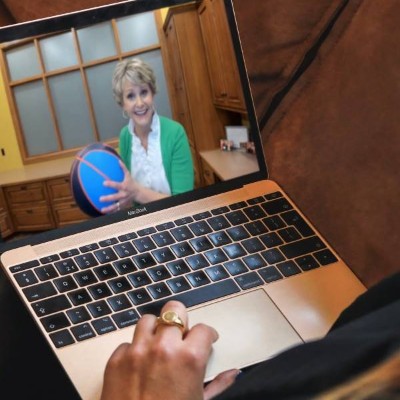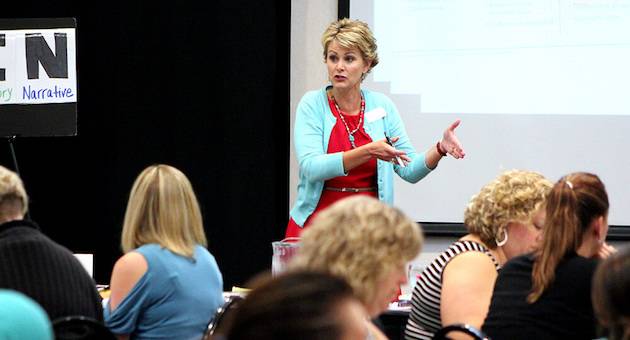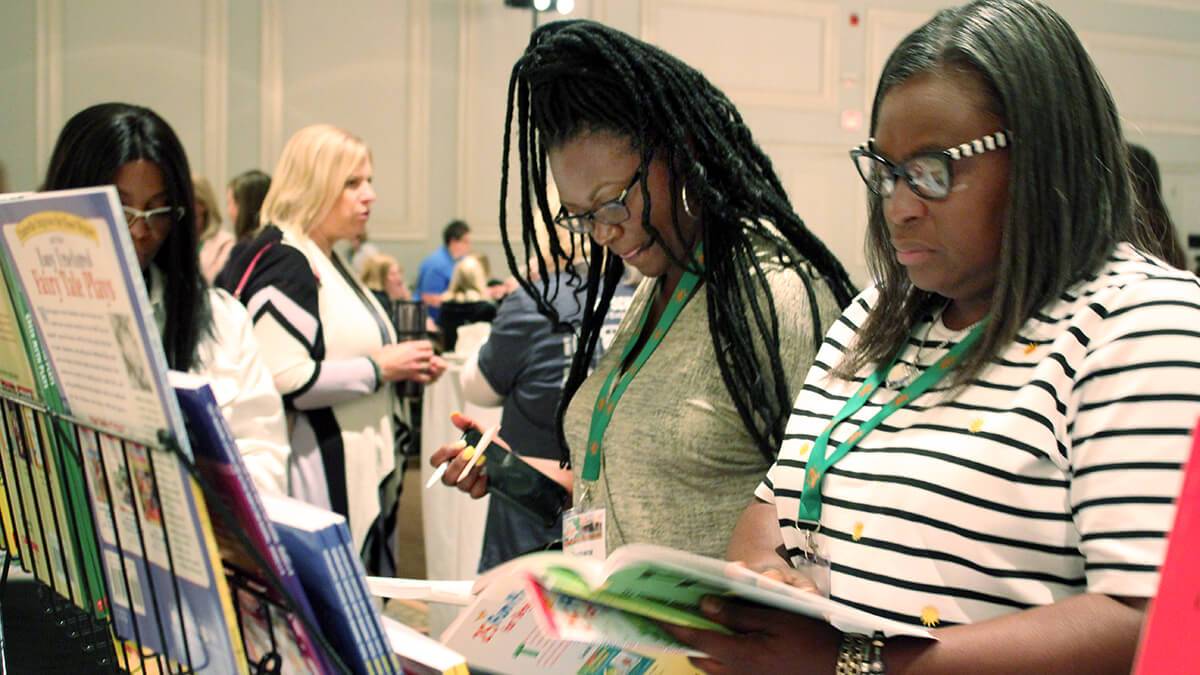Teacher burnout: how professional development can help
by Michelle Schweikhardt
A blazing issue
Burnout is the depletion of a fuel or substance due to use or combustion. It only makes sense that this is the word used to describe what is happening—teachers are exhausting their “fuel” and resources until they have nothing left.

If there is any doubt as to whether burnout is a rising issue in education, consider how teacher burnout rates compare to those of other professions. Multiple surveys provide a stark contrast between the education sector and the rest of the U.S. workforce.
A recent publication from the RAND Corporation shared that teachers and principals experience significantly more job-related stress and burnout than other workers. Another poll from Gallup showed that k-12 educators rank as the most burnt-out group in the U.S. workforce.
Although this is not an all-encompassing list, teacher burnout largely stems from:
-
- Little control over instructional decision-making
- A lack of resources
- Feeling overworked
- A lack of appropriate compensation
- Large class sizes
- Little work-life balance
- Classroom management difficulties
- Politics/Social issues
- National and state-level policies
Teaching is a rewarding career, but let’s be honest—teachers are tired.
Teachers are tired of missing out on daylight and any semblance of a balanced life as they arrive at school before sunrise and leave after sunset. They are exhausted with grading, planning, and prepping, consuming the weekend while everyone else enjoys time with loved ones. Teachers are tired of the constant pressures from high-stakes testing and continually being asked to do more with less.
Admittedly, these things, and much more, are part of the job. Nevertheless, the constant pressures piled on teachers are fueling widespread teacher burnout.
While the outlook may seem bleak since several factors contributing to teacher burnout are out of their control, educators can take matters into their own hands to combat burnout.
Investing in professional development, whether through workshops, online courses, or professional networks, can make all the difference in preventing burnout. Educators can leverage the power of professional development for teachers to reignite their fire for teaching and bring back the joy and fulfillment of the profession.

Reignite these key areas with professional development.
Knowing that teachers can combat burnout with professional development, it’s important to focus teachers’ professional development efforts on the main factors that drain teachers of time, energy, and morale:
Classroom management
Unruly students contribute to burnout, but is it always the students’ fault? A lack of clear directives or overwhelming expectations can create a less desirable learning environment.
If teachers feel overwhelmed by the day-to-day happenings in their classrooms, professional development with practical strategies can help. Whether classroom management is the direct focus of professional development or effectively integrated with another learning topic, teachers can explore different approaches aligned with their teaching style and the needs of their students, ultimately leading to a more productive and effective classroom.
Content knowledge
In light of the ever-evolving research and best practices in education, teachers feel pressured to stay up to date to ensure that their teaching methods are relevant and practical. However, these new methods overwhelm teachers who lack the content knowledge to support their teaching, leading to stress and confusion. Professional development can provide content knowledge as a foundation for teachers so that they feel better equipped to meet the needs of their students.
Pedagogy
Pedagogy is the broad overview and foundational philosophy of teaching methods, activities, and assessments. Participating in professional development opportunities focused on pedagogy helps teachers avoid wasting time guessing what works. By learning proven best practices, teachers teach confidently, knowing they are helping their students succeed.
School Culture
School culture is an often overlooked area that can impact student outcomes. By attending professional development sessions focused on building a positive and supportive school culture, teachers can learn how to create an environment where all students, staff, and families feel valued and respected.
Professional development can also help teachers learn ways to build relationships with students and families. When teachers have good working relationships with parents, students are supported, parents feel heard, and teachers feel validated—everyone wins.
Collegiality
When teachers have a supportive network of colleagues, they are more likely to feel comfortable sharing their concerns and asking for help. This translates to a more positive and productive work environment. However, when teachers struggle with collegiality, the network of support dissipates.
By engaging teachers in meaningful collaborative learning, they can learn how to overcome differences and build strong working relationships.

FREE ON-DEMAND WEBINAR
Advance Beyond Doing Reading to Teaching Reading
Learn what explicit, whole-class comprehension instruction looks like and how to effectively scaffold mini-lessons within the rest of the reading block to honor the gradual release of responsibility.

Earn a completion certificate
60-minute webinar
Professional development fuels change
Experiencing teacher burnout is like being a marathon runner who runs out of water and energy. Just like a marathon runner needs to refuel and rehydrate at regular intervals to avoid running out of energy and collapsing, teachers need to refuel regularly to prevent collapse.
Professional development can be the change agent that provides teachers with the energy they need to prevent and reduce burnout and remain enthusiastic about their choice to become an educator.
For example, educators can become inspired by a high-energy teacher workshop that features practical, best-practice strategies that work.
When educators know they are not wasting their time by participating in boring or irrelevant professional learning, there are two important results.
1. Work-life balance
Professional development can help to alleviate some of the time spent researching lesson plans and preparing materials. When teachers sharpen their understanding of effective ways to teach, they can eliminate strategies and resources that don’t work. This allows them to streamline their planning and instruction, leaving more time for life outside of school.
2. Professional validation
When teachers participate in professional development that also includes the necessary resources for implementation, the impact on teacher burnout can be very positive. When relevant teaching materials are provided in tandem with professional learning, educators naturally feel more validated and supported and less isolated.
Professional development
can be the change agent
that provides teachers with
the energy they need to
prevent and reduce burnout.
The positive impact of teacher professional development may sound too good to be true, but research shows that continuous learning impacts job satisfaction. The 2012 MetLife Survey of American Teachers found that teachers who benefited from quality professional development opportunities and collaborative time with colleagues were more likely to express higher job satisfaction (Northwest Comprehensive Center, 2014, p. 14).
Let’s also revisit the fact that burnout has a direct impact on students. Research from the Regional Educational Laboratory Southwest has proven that meaningful professional development can raise student achievement by nearly 21%.
Strategies for effective professional development
Now is the time to “recharge” educators. Professional development for educators can become reinvigorating when it is timely, systemic, and focuses on student and teacher needs.
So how is this achieved?
Identify and prioritize student and teacher needs.
Start by looking at student achievement data alongside the skill set and experience of teachers. If achievement scores are signaling that a particular area needs improvement, pursuing professional development on that topic is a common-sense move.
Create a personalized professional development plan.
For substantive change to occur, it requires a plan. To create a realistic and practical professional development plan, weigh the impact of factors such as the time line, financial limitations, and strategic goals. Whether it’s a district-wide plan or an individual one, a professional development plan should incorporate the features of high-quality PD, including:
- Active learning.
- Best practices.
- Resources.
- Collaboration.
- Opportunities for reflection and feedback.
Stay committed to implementation.
For professional learning to take hold, teachers and other stakeholders need to implement what they learn. For this to happen, teachers need to be provided with the appropriate resources, along with coaching, mentoring, and time, to work and collaborate with peers.
Measure and evaluate the impact of teachers’ professional development.
Follow up with teachers to gather data on the knowledge, skills, performance, and outcomes of the professional development program. Use the data to construct a more complete picture of the program’s effectiveness. This final but easy-to-overlook action is a must-do to ensure professional development provides teacher support and improves student achievement.
Now’s the time to recharge
Professional development allows teachers to learn new strategies, gain fresh perspectives, and connect with colleagues facing similar challenges. At a time when teachers have little control over the many factors contributing to burnout, teachers have a chance, through professional development, to spark their passion for learning and reignite their fire for teaching.
With the right professional development teacher opportunities, educators can rekindle their enthusiasm, enhance teaching skills, and regain a sense of purpose while impacting student learning.
Customized training to rekindle your spark—from Smekens Education
When you’re feeling burnt out, find out how Smekens Education can spark your passion for teaching again.
Professional Development Services
TEACHER TRAINING

CUSTOMIZED CONSULTING

BOOKS & RESOURCES


